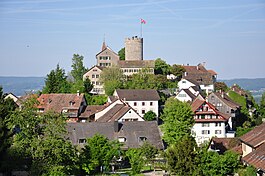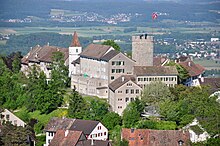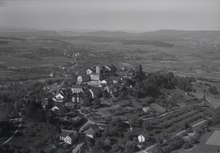Regensberg
This articleneeds additional citations forverification.(August 2024) |
Regensberg | |
|---|---|
 Regensberg pictured in 2010 | |
| Coordinates:47°29′N8°26′E/ 47.483°N 8.433°E | |
| Country | Switzerland |
| Canton | Zurich |
| District | Dielsdorf |
| Government | |
| •Mayor | Matthias Reetz |
| Area | |
| • Total | 2.37 km2(0.92 sq mi) |
| Elevation | 617 m (2,024 ft) |
| Population (31 December 2018)[2] | |
| • Total | 485 |
| • Density | 200/km2(530/sq mi) |
| Time zone | UTC+01:00(Central European Time) |
| • Summer (DST) | UTC+02:00(Central European Summer Time) |
| Postal code(s) | 8158 |
| SFOS number | 0095 |
| ISO 3166 code | CH-ZH |
| Surrounded by | Boppelsen,Buchs,Dielsdorf,Oberweningen,Schleinikon,Steinmaur |
| Website | www SFSO statistics |


Regensbergis amunicipalityin theDielsdorf Districtin the SwisscantonofZurich.It is located just to the west ofDielsdorfmunicipality, on a ridge of theLägern(617 m (2,024 ft)).
History
[edit]Regensberg was founded as a hilltop fortified settlement about 1245 by Baron Lüthold of Regensberg. Thefortificationsinclude a 21 m (69 ft)-high round tower dating from the 16th or 17th century and a 57 m (187 ft)-deep water well.Regensberg Reformed Church,originally dating from the 13th century, was rebuilt around 1540.[3]

During the mid-13th century, relations between the Barons of Regensberg and the city ofZurichbecame strained. At about this same time, the barons began to argue with theHabsburgsover who would inherit the lands of the now-extinctKyburgfamily. In 1267, the disputes led to war between the barons and the combined Zurich and Habsburg forces. The barons lost this war, and rapidly declined in power over the following half-century. In 1302, they sold Regensberg to the Habsburgs.
The Habsburgs established anAmt Regensberg,with a Habsburg-appointedSchultheißleading the town council. Under the Habsburgs, the town expanded into amarket town,and Regensberg Castle was the political centre of the area now corresponding to theDielsdorf district.
In 1409, the Habsburg dukeFrederick IV(known asFrederick of the Empty Pockets) had to pawn Regensberg to the city of Zurich; however, it wasn't until 1417 that Regensberg was fully owned by the city. They established anObervogteiat Regensberg which ruled over thirteen surrounding villages.
In 1540, the upper castle burned down, but the lower gates and thedonjonsurvived because they were separated from the upper castle by a deep ditch. The upper castle was rebuilt the following year. During theReformation in Zürich,St. Martin's Abbey onZürichbergatFlunternwas demolished. Stone blocks and two bells from the abbey were brought byox cartto the church at Regensberg to rebuild it.
Following the collapse of the SwissAncien Régimein 1798, Regensburg became part of thedistrict of Bülach.In 1803, with theAct of Mediation,Regensberg became the capital of its own sub-district. In 1831, this expanded to become the district of Regensberg. In 1871, the capital of the district moved to Dielsdorf, and Regensberg became an independent municipality in that district.[4]
Historic attractions include the half-timbered "Rote Rose" house dating from 1540.
Citizens
[edit]Eberhard IIwas born in Regensberg around 1170 and died inFriesach,Austria, on 30 November 1246. In 1196, he received theBishopric of Brixenand, in 1200, theArchbishopric of Salzburg.Eberhard founded the independentbishopricsofChiemsee(1215),Seckau(1218) andLavant(1228) under Salzburg, as well as the collegiate churches ofVölkermarktand Friesach, where he also founded aPremonstratensianmonastery in 1217. Eberhard added the counties ofPongauandLungauto the Archbishopric. He was excommunicated in 1245 after refusing to publish a decree deposing the emperor and died suddenly the next year.
Geography
[edit]
Regensberg has an area of 2.4 km2(0.93 sq mi). Of this area, 34.5% is used for agricultural purposes, while 56.7% is forested. The rest of the land, 8.8%, is settled.[5]
Demographics
[edit]Regensberg has a population (as of 31 December 2020) of 459.[6]As of 2007[update],16.3% of the population was made up of foreign nationals. Over the last ten years the population has decreased at a rate of -1.3%. Most of the population (as of 2000[update]) speaks German (93.0%), with French being second-most-common ( 1.6%) and English being third ( 1.2%).
In the 2007 election, the most popular party was theSwiss People's Party,which received 31.1% of the vote. The next three most popular parties were theFDP(17.9%), theGreen Party(14.5%) and theSPS(13.7%).
The age distribution of the population (as of 2000[update]): children and teenagers (0–19 years old) make up 23.8% of the population, while adults (20–64 years old) make up 65.9% and seniors (over 64 years old) make up 10.3%. In Regensberg about 86.8% of the population (between age 25-64) have completed either non-mandatoryupper secondary educationor additional higher education (either university or aFachhochschule).
Regensberg has an unemployment rate of 1.48%. As of 2005[update],there were eighteen people employed in theprimary economic sectorand about six businesses involved in this sector. Fourteen people are employed in thesecondary sectorand there are three businesses in this sector. 121 people are employed in thetertiary sector,with sixteen businesses in this sector.[5]
References
[edit]- ^ab"Arealstatistik Standard - Gemeinden nach 4 Hauptbereichen".Federal Statistical Office.Retrieved13 January2019.
- ^"Ständige Wohnbevölkerung nach Staatsangehörigkeitskategorie Geschlecht und Gemeinde; Provisorische Jahresergebnisse; 2018".Federal Statistical Office. 9 April 2019.Retrieved11 April2019.
- ^"Kirchengeschichte".Reformierte Kirchgemeinde Regensberg(in German).Retrieved2024-08-11.
- ^Regensberg websitehistory.(in German)accessed 4 August 2009
- ^abSwiss Federal Statistical Officeaccessed 04-Aug-2009
- ^"Ständige und nichtständige Wohnbevölkerung nach institutionellen Gliederungen, Geburtsort und Staatsangehörigkeit".bfs.admin.ch(in German). Swiss Federal Statistical Office - STAT-TAB. 31 December 2020.Retrieved21 September2021.
External links
[edit]- Official website(in German)
- Commune flag




